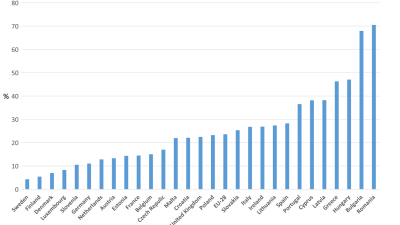The table below shows the percentage of adults in each income quintile who cannot afford various levels of necessities, from one or more to ten or more. The income quintiles are based on household incomes after housing costs equivalised using the PSE scale (see PSE Income measures). The list of necessities included can be found under Deprivation tables.
Source: PSE UK 2012
Notes: from 4 plus necessities upwards for the top quintile and from 7 plus upwards for those in the second quintile, the percentages are based on a small number of respondents.
Download csv file
Overview
At all levels of lack, there is a tight correlation between the level of deprivation and household income - those in households on lower levels of income being much more likely to be unable to afford necessities than those in households on higher levels of income. For those in the bottom quintile, the percentage of the group being unable to afford the different levels of necessities drops fairly evenly from 80% for one or more necessities down to 12% for 10 or more. For those in the top quintile, the percentage unable to afford necessities drops sharply between 1 or more necessities and three or more necessities from 28% to 8%.
Incomes fluctuate over time. This means that at every level of current income there is variation in the number of necessities lacked. Some of those on the lower incomes will have only recently moved into this situation and will already possess many of the necessities, they may also have additional resources and savings to draw on. They will therefore have lower levels of deprivation than those who have been in the lowest income groups for long periods of their life. Significant proportions of those on lower incomes have high levels of multiple deprivation with 45% lacking five or more necessities and 39% lacking 6 or more.
For those currently in the higher income groups, some will only recently have obtained this higher income and their living standards have not yet adjusted. For some of this group, the increase in income may be long term (through, for example, promotion or an additional household member finding employment) and they are likely to raise their living standards over time. On the other hand, for some this may be only a temporary increase in income (for example, as a result of a one-off piece of overtime or temporary job), and they may not be able to improve their situation.
At all levels on income, there will be some who have additional financial commitments and debts which are impacting – and will continue to impact – on their living standards. For others, there will be caring responsibilities (looking after elderly parents or a disabled relative, for example) that impose extra financial strain.
When looking at deprivation, the PSE takes those who cannot afford three or more adult necessities as being deprived whatever their level of income (see Falling Below Minimum standards and the PSE first report, 'The impoverishment of the UK'). They have multiple deprivations that impact on their way of life. They fall below society’s minimum living standard.
The PSE measure of poverty uses a combined income and deprivation measure, with those in poverty being those who are both deprived and on a low income. See ‘Producing an ‘objective’ poverty line in eight easy steps: PSE 2012 Survey: Adults & Children’, by David Gordon, forthcoming, and David Gordon’s presentation to the PSE final conference on ‘The extent of poverty in the UK’.
Further information
For further discussion on how multiple deprivation at the level of 3 or more necessities impacts on people's lives see Chapter 2 of 'Breadline Britain – the rise in mass poverty', by Stewart Lansley and Joanna Mack (Oneworld, 2015, £9.99).
Survey details
See PSE Survey details for the PSE UK 2012 Living Standards survey sampling size and frame.
First posted: 1 June, 2016
Author: Joanna Mack



 PSE:UK is a major collaboration between the University of Bristol, Heriot-Watt University, The Open University, Queen's University Belfast, University of Glasgow and the University of York working with the National Centre for Social Research and the Northern Ireland Statistics and Research Agency. ESRC Grant RES-060-25-0052.
PSE:UK is a major collaboration between the University of Bristol, Heriot-Watt University, The Open University, Queen's University Belfast, University of Glasgow and the University of York working with the National Centre for Social Research and the Northern Ireland Statistics and Research Agency. ESRC Grant RES-060-25-0052.






